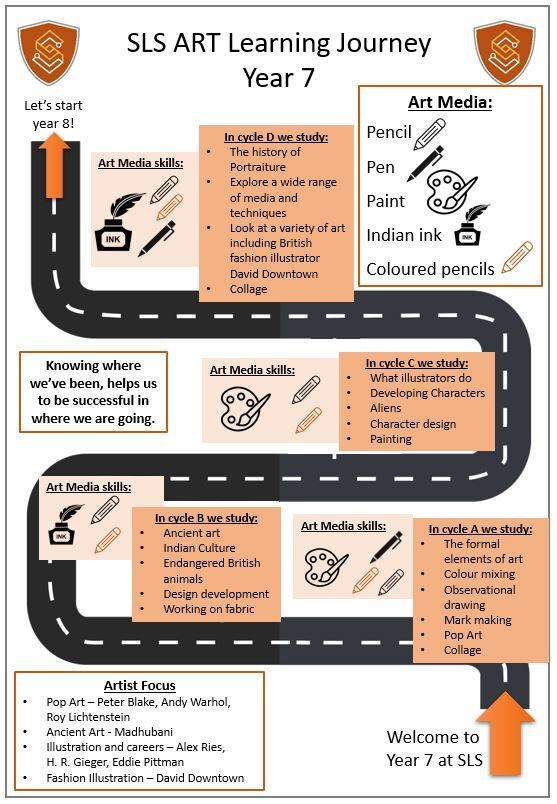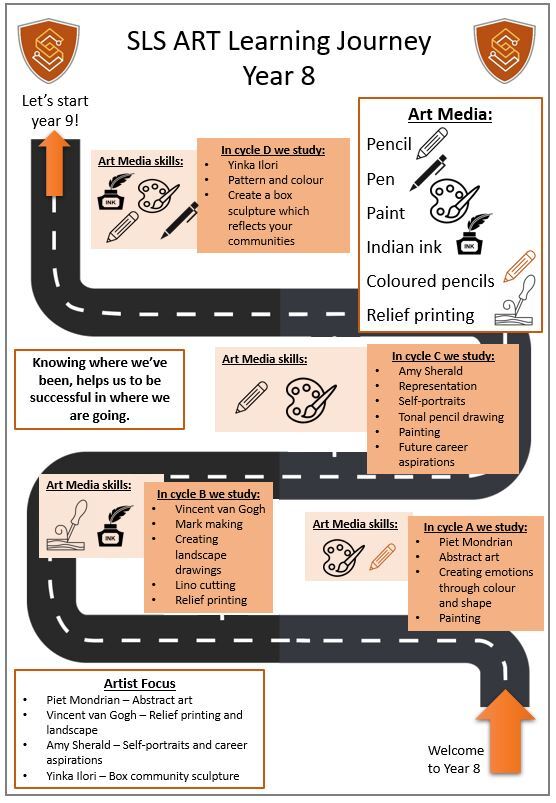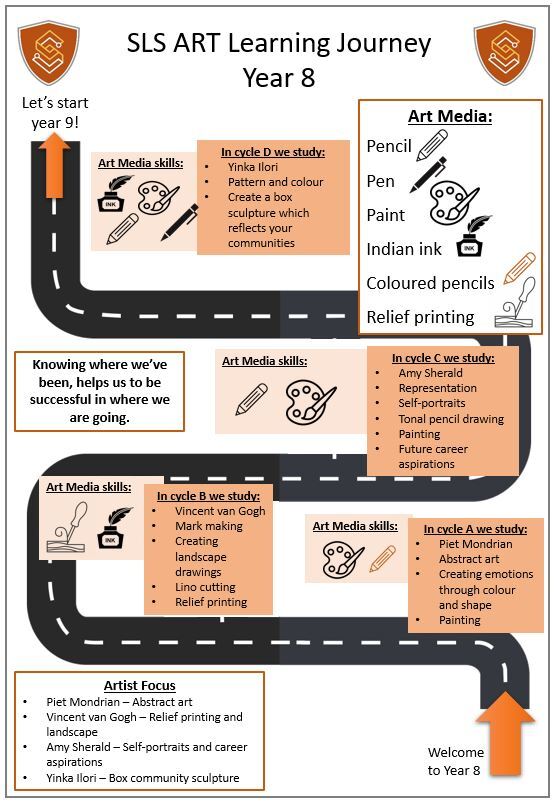Art
Department Vision:
To give students the opportunity to explore and learn about a wide variety of art to develop their visual language to tell their own stories.
We have created an exciting, challenging and varied curriculum which enables all students to build the technical skills needed in Art, which they then use to develop their own visual language to tell their stories. We do this by learning about the art of both historic and contemporary artists. This enables all students the chance to experience using a wide range of art media and have success in the subject, whilst building in core skills and learning numerous techniques. By learning about a vast range of varied visual artists we get to explore art’s cultural impact around the world and through our focus of including a wide range of contemporary, working artists, students have the chance to learn about careers in the creative industry. Alongside building practical skills we have incorporated reciprocal reading into the curriculum to help analyse and interpret artworks and improve literacy, students can talk and write confidently about artworks and give informed opinions.
Year 7
Year 7

|
Cycle A |
In year 7 we build skills and confidence in art. Cycle A we study Pop art and use it as a focus to create a mixed media collage to tell the story of ourselves and our likes. We build skills in observational drawing, mark making and learn about colour theory using the medium paint. |
|
Cycle B |
Cycle B we look back through history at the ancient art of Madhubani. We use this as inspiration to inform our own designs around endangered British animals using the medium of ink and working on fabric. |
|
Cycle C |
Cycle C we explore the way illustrators work in the ‘real world’ and design our own aliens developing our skills with watercolour paint. |
|
Cycle D |
We finish the year in Cycle D studying portraiture and create self-portraits. We create the different parts of our faces exploring and developing our skills with Indian ink, pencil, monoprints and coloured pencil and papers. These smaller artworks are then collaged together to make a self-portrait. |
Year 8
Year 8

|
Cycle A |
Cycle A we focus on Abstract art in Europe after World War 1, looking at Piet Mondrian. We study colour theory and work towards creating a final piece which uses colour and shape to convey an emotion working in the medium paint. |
|
Cycle B |
Cycle B we re-visit mark making looking at Vincent van Gogh. We create rural landscape designs which inform out linocut relief prints. |
|
Cycle C |
Self-portraits and representation are the theme of Cycle C and we use contemporary artist Amy Sherald to do this. Students build skills and knowledge about how to draw a self-portrait and include future career aspirations in their final outcomes. |
|
Cycle D |
We end the year by creating a box sculpture around the theme community, which requires students to use a wide variety of art media and we explore the work of London based artist and designer Yinka Ilori. |
Year 9
Year 9

|
Cycle A |
Students work to fulfil a design brief around the theme ‘Objects and Belongings’. Our artists focus are Michael Craig-Martin and Giorgio Morandi. We explore and experiment with a wide range of media and create a personal response working in the medium chosen by the student. |
|
Cycle B |
Cycle B’s theme is ‘Newspaper Headlines’. Focussing on artist and graphic designer Shepard Fairey, students explore how graphic designers use desktop publishing software to create their own designs based on someone from the news that means something to them. They then re-create this work in the medium paint working on their painting and colour mixing skills. |
|
Cycle C |
Cycle C the theme is ‘Surroundings’ where we focus on the architecture around us. We study artist David Hockney and look at his photography work. We build skills in perspective drawing and creating our own ‘joiner’ photography to use as a primary source to draw from. |
|
Cycle D |
Cycle D we continue with the theme ‘Surroundings’ and build on the work we created in Cycle C. This time focussing on artist El Anatsui and his sculpture work on recycled materials. Students develop their work by creating a final outcome on recycled materials using a wide variety of art media, showing off the skills they have developed during KS3. |
Years 10 & 11
Having gained competence from practice in KS3 of our core conceptual skills of researching and creating contextual studies, experimenting and developing ideas around a theme, recording ideas and developments and then creating a final, personal response, our artists are shaped further in Key Stage 4. Students will continue to utilise and enhance the core conceptual skills of an artist whilst being challenged to develop their own visual language to tell their own stories.
We follow the Edexcel GCSE Fine Art two year course.
- Component 1 – Portfolio (Coursework) – 60%
- Component 2 – Externally set assignment (Exam) – 40%
- The exam unit begins in January of Y11.
The theme for year 10 is ‘Layers’. This means the work we create will be related to this theme in some way. We will be looking at a wide variety of ways to explore this theme, developing our accuracy in our drawing using both primary and secondary sources. We will learn a variety of skills and techniques which will make us stronger as artists. We will choose sources that inspire us, decide what materials and media we want to work with and create skilful and meaningful outcomes.
Year 10
|
TERM 1 |
Artist focus: Karl Blossfeldt, Anna Farba and Joseph Cornell. |
|
TERM 2 |
Artist focus: Karl Blossfeldt, Anna Farba and Joseph Cornell. |
|
TERM 3 |
Artist focus: Barbara Walker, Amy Sherald and Victoria Villasana |
|
TERM 4 |
Artist focus: Barbara Walker, Amy Sherald and Victoria Villasana |
|
TERM 5 |
Artist focus: Barbara Walker, Amy Sherald and Victoria Villasana |
|
TERM 6 |
Student lead project around the theme ‘Layers’. |
Year 11
|
TERM 1 |
Mock exam assignment. |
|
TERM 2 |
Mock exam assignment. |
|
TERM 3 |
Externally set assignment (Exam) |
|
TERM 4 |
Externally set assignment (Exam) |
|
TERM 5 |
Externally set assignment (Exam) |
|
TERM 6 |
Externally set assignment (Exam) |
Advice for Parents & Carers
Art is a reflection of society and culture. It helps us understand what we are as human beings and influences how we relate to each other. It acts as a collective memory of society. Employment in the creative industries in the UK continues to be one of the fastest growing sectors with a wide range of employment opportunities.
Visiting any Art gallery is hugely beneficial. We are incredibly lucky to have easy access into London, which has some of the best galleries and museums in the world.
Almost all of the major galleries in London are free; the National Gallery, the National Portrait Gallery, Tate Modern and Tate Britain, the Royal Academy of Arts, the Victoria & Albert Museum and The British Museum.
The following websites are invaluable to students. We encourage you to support your child to use them for independent studies:
















